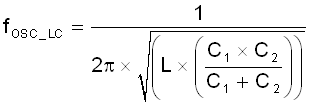ZHCSJ59C december 2018 – july 2023 LDC5072-Q1
PRODUCTION DATA
- 1
- 1 特性
- 2 应用
- 3 说明
- 4 Revision History
- 5 说明(续)
- 6 Pin Configuration and Functions
- 7 Specifications
- 8 Detailed Description
- 9 Application and Implementation
- 10Power Supply Recommendations
- 11Layout
- 12Device and Documentation Support
- 13Mechanical, Packaging, and Orderable Information
8.3.2 Excitation Signal
The excitation signal is generated by an LC oscillator. The LCIN and LCOUT pins will be connected to the excitation coil. The oscillator signal driver automatically regulates the signal to VAMP_LC. The user can adjust the external capacitors on LCIN and LCOUT to select the excitation frequency. For best performance, two capacitors should be used. One should be placed from LCIN to ground and the other from LCOUT to ground (C1 and C2). This is instead of using one capacitor between LCIN and LCOUT.
Use Equation 1 to calculate the excitation frequency.
Equation 1. 

where
- L is inductance of excitation coil
- C1, C2 are the external capacitors on LCIN and LCOUT, respectively